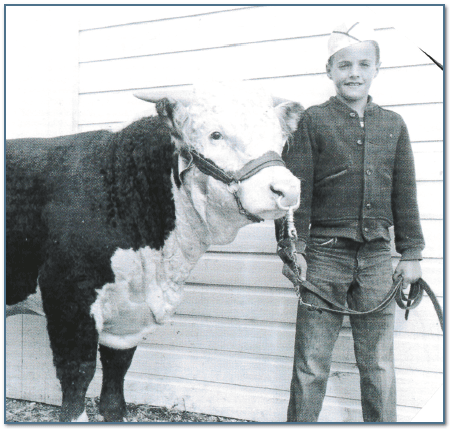Thoughts from the Archives – 70 Years of 4-H
Chances are you know the Home is celebrating its 100th anniversary in 2020. Plans are being made for a year full of activities for all in our family to enjoy.
Perhaps, however, you didn’t know the Home’s 4-H program is rightly proud of its 70th anniversary this year and is proudly expanding its program to allow for community participation along with our residents.
It all started in 1948 when Ted Talboe, the barber at the Livestock Exchange Building at the stockyards, told one of his customers, cattleman Bob Cooper, he should learn about the Omaha Masonic Home for Boys which had recently moved to a 59-acre property in North Omaha.

Not long after, Cal Reichart heard knocking on the door of the Shrine Cottage one morning. He met Bob Cooper who asked about the possibility of a 4-H program for the residents. Together they toured an old rabbit hutch on the property. Mr. Reichart opined it could handle up to six calves for the boys to raise. Soon six calves arrived and the 4-H program was started.
It took several years for purple ribbons and championships to be attained, but attained they were. Don Hargis, an 11-year resident and member of the Benson Class of 1957, claims he won the first purple ribbon he ever knew about. (Any challengers?)
Two years into the program in 1950, Mr. Cooper felt 4-H needed its own “home” so to speak. He presented the Home with a 72-acre stock farm three miles north of the main campus. The farm was widely known as the Simpson Mule Farm. Each year officers of the British army would visit the mule farm to pack hundreds of mules for shipment to India to haul military equipment up and down the hilly terrain. World War II and mechanization
ended that colorful program. After Bob Cooper’s tragic death in a car accident in 1957, the farm would come to be known as Cooper Memorial Farm.
In the early 1950’s twelve boys and their house parents moved to the converted farm home at the new farm. In 1952 a cottage was built for Felix Carpenter, the manager of farm operations who had overseen the early
development of the Home’s two campuses.
The 4-H program benefitted greatly from calves donated by local ranchers and each year since 1950 the farm manager would make his annual visit out and about to pick up the animals. Many of the ranchers have donated
for decades.
The end result of the 4-H projects is participation in shows at the local county fairs, cattle shows in Fremont, shows at Ak-Sar-Ben and occasionally the Nebraska State Fair.
A picnic pavilion for public use was built atop the hill in 1952 and it was replaced by a new pavilion in 1993. An expanded residential cottage was built in 1960 and the James D. and Winifred Watson Trust funded a large 4-H training center in 1988. Our master of ceremonies at the dedication program termed it “the Hyatt House for livestock in Douglas County.”
Throughout the seven decades of serving hundreds of youngsters who could benefit from 4-H, many changes, of necessity, have been seen. Through half of those 70 years one man, Cooper Farm Manager Mike Pallas, has been around to see these changes and guide them to fruition. Since 1987 Mike has had as his Assistant Manager, Kelly Armbrust, a former resident of the Home during the 1980’s.
Today the Home’s 4-H program works with two other youth-serving agencies, the Uta Halee Academy and NOVA Treatment Community. Youth from these two organizations work on their calves side by side with the
residents of the Home.
Congratulations to the 70-year-old 4-H program, Mike Pallas and Kelly Armbrust who make it go, and UTA Halee and NOVA for carrying on this fine tradition.